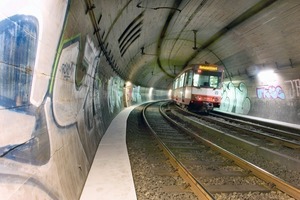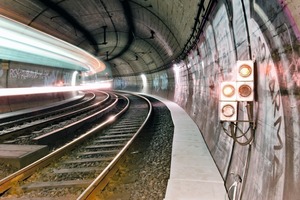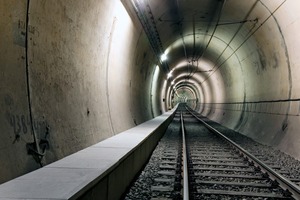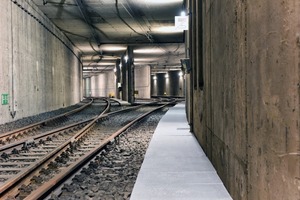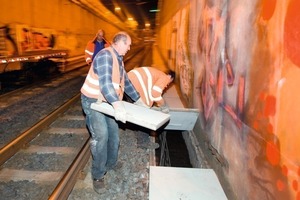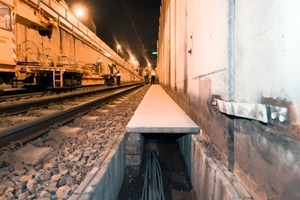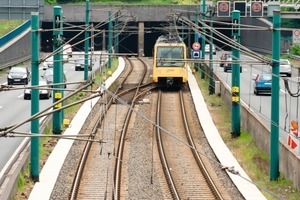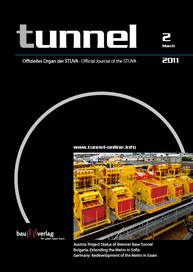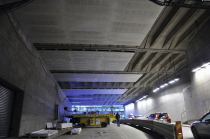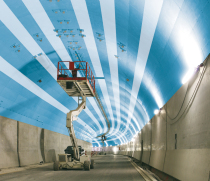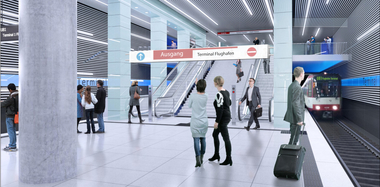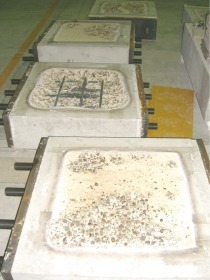Redevelopment of the Essen Underground System
In the Essen Underground system the old covers for cable troughs made of timber and concrete slabs were replaced by special glass fibre light concrete fire protection elements. They are slip-proof, negotiable and dynamically load resistant given a low intrinsic weight, non-inflammable and possess a high water and frost resistance.
Safe fire protection is essential in underground transportation facilities. Underground railway tunnels require a balanced concept of technical measures for fire protection on account of the particular surrounding conditions in order to cater for successful evacuation in the event of fire. The cable troughs generally installed at the sides parallel to the rails, which house and carry signal, telecommunication and high-voltage cables, have a special role to play in this connection. They are devised in such a way that they can also be utilised as a means of escape in the event of a fire incident and are intended to ensure that the Underground system can be evacuated quickly. In order to be able to fulfil this function safely high demands are posed on the trough covers in particular. They must not simply be non-inflammable and resist high force effects, but they must also be resistant to water and frost to a considerable degree. After all trains passing through bring a great deal of moisture into the tunnels above all when it rains.
As it is the troughs are subject to permanent moisture and frost influences as a result of the special climatic influences prevalent in the tunnels as well as the fact that the troughs are partially or completely laid in the ground. Only few materials can cope with all these factors.
Requiring Redevelopment
Stability problems as well as insufficient fire protection caused the Essener Verkehrs AG (EVAG) to renew the covers of the cable troughs in the Underground network within the scope of extensive redevelopment measures. “The covers,” Bertram Gröpper in charge of engineering structures within the EVAG says in explaining the measure “were made of timber or concrete. As far as timber is concerned, we are faced with the problem that the planks weather extremely quickly on account of the effect of moisture. In addition it is impossible to provide permanent fire protection. The concrete covers had become unstable owing to corrosion damage affecting the reinforcement during the course of time. In some case they simply broke without warning when being inspected”. Furthermore Gröpper added work with cables in areas covered by concrete is extremely complex: “Work was most diffi-cult, extremely exhausting for our staff and very complicated on account of the heavy weight of the concrete”.
Extensive Demands
In order to facilitate future inspections, a product was selected during the redevelopment phase, which possesses a high mechanical load resistance given relatively low weight and fulfils the technical requirements governing fire protection according to DIN 4102. “As we had to renovate the covers on the surface routes at the same time as the running tunnels,” Bertram Gröpper said relating to the demands posed, “the covering plates had to be capable of being installed to cope with all kinds of weather as well as being resistant to water and frost”.
Subsequently the choice fell on the negotiable and dynamically loadable Aestuver fire protection element D+2 produced by Fermacell Aestuver, which was specially devised for safely creating evacuation and rescue routes in underground transportation facilities. The elements tested in accordance with DIN EN 13501-1 (DIN 4102, Part 1) are non-inflammable (material class A1 according to DIN 4102) and suitable even for resisting high temperatures in tunnels. At the same time the composition of the boards without inflammable components prevents the release of toxic or visibility-hampering gases in the event of fire.
The matrix set-up comprising expanded glass granulate combined with alkali-resistant glass fibres for reinforcement as well as a special production method, whereby the long glass fibres are set out uniformly to cover the entire board structure cater for low weight of approx. 46 kg/m² - corresponding to 20 kg per element – and for high compressive and bending strength. In spite of being only 52.5 mm thick the board affords a permissible service load of 12.5 kN/m² given a trough width of 60 cm (corresponding to 1.25 t/m²). The acceptance of dynamic loads was confirmed by the material testing office MFPA Leipzig following extensive tests. Bertram Gröpper: “We tested the crack resistance together with the technical supervisory authority on the spot”.
Water and Frost Resistance
As the expanded glass granulate and glass fibres do not absorb water, the D+2 fire protection elements also fulfil the high water and frost resistance values required for application in the Essen Underground system. The manufacturer has undertaken numerous tests to prove the water resistance of the D+2 fire protection elements. In this connection it was revealed that the elements do not absorb any water but remain floating on it, whereas conventional fire protection boards drop to the bottom. The physical properties also do not prevent underwater storage.
The frost resistance of the elements was also tested positively in lengthy series of over 100 frost-thaw cycles. The special material composition furthermore assures that the boards do not rot or become mouldy. They are not attacked by pests.
In order to assure maximum safety, non-slip elements were used for redeveloping the Essen Underground system. In this connection slip-resistant class R 10 trough covers were used in the tunnel section whereas boards with an additional coating made of quartz sand in anti-slip class R 13 were employed.
Precut Parts from the Factory
Altogether more than 2,500 D+2 fire protection elements were used for the Essen Underground system. The individual elements were produced at the factory in the required dimensions of 700 x 622 mm (standard format roughly 625 x 1,250 mm) according to EVAG specifications and delivery to the construction site. “It goes without saying,” Bertram Gröpper said “that we ordered the boards so that we needed to cut as little as possible”. However, as the tunnels do not always run straight and the dimensions of the troughs also vary, adjustments could not altogether be avoided. The precut parts were tackled with standard tools on the spot without any problem.
The low intrinsic weight of the glass fibre light concrete boards turned out to be an advantage. It was possible to lay the individual elements in a fast and straightforward manner. All that was necessary was to set them on the concrete troughs. The 2 narrow strips attached at the factory lengthwise on the lower side served to secure their position preventing the boards from becoming displaced at the sides.
As Bertram Gröpper said: “the low intrinsic weight in particular was an important aspect in selecting the product especially regarding the technical inspections, which have to be carried out regularly. This considerably reduces any hassle, speeds up operations and does not negatively affect our colleagues’ health. In future our members of staff will be able to undertake inspections far more easily”.
Summary
The evacuation and routes in the Essen Underground system were redeveloped. Special, particularly stable fire protection elements made of glass fibre light concrete, which are manufactured by a special production process, cater for the utmost safety. The low weight at the same time simplifies the technical inspections, which are executed on a regular basis.

